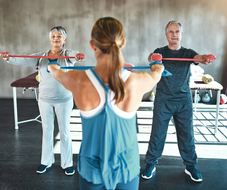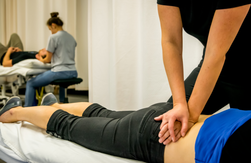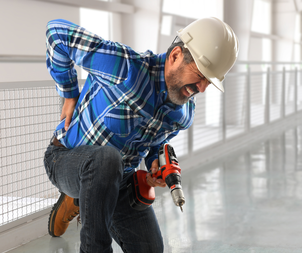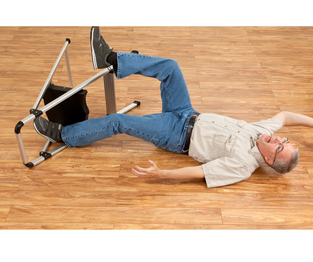 Dizziness is a common problem affecting between 15% and 20% of people each year. It significantly impacts daily life, causing feelings of unsteadiness, lightheadedness, or sensations of the room spinning. These symptoms can be alarming and significantly hinder the ability to complete even basic tasks. The good news is that dizziness often has treatable causes. The fact that physical therapists can be a key player in treating dizziness surprises many people. Understanding dizziness: Dizziness isn't a specific disease but a symptom with various origins. Inner ear issues are a frequent culprit, but vision problems, neck or muscle issues, migraines, blood pressure changes, head injuries, and neurological problems can also contribute. What do physical therapists have to do with dizziness? PTs are known as movement and musculoskeletal experts, but they also frequently treat balance problems. That's how they play a role in treating dizziness. Balance relies on a complex interplay between the inner ear, vision, and sensory input from your joints. When this information becomes conflicting, the brain struggles to interpret it, leading to a feeling of dizziness or vertigo. Physical therapists assess all these systems to pinpoint the underlying cause of dizziness. This tailored approach leads to an effective treatment plan. That plan might include: ● Exercises: These might be designed to improve balance, strengthen specific muscles, or retrain the brain to process sensory information correctly. This could involve gaze stabilization exercises to help the brain and vision work together, habituation exercises to desensitize the brain to specific triggers, and balance training on various surfaces. ● Canalith Repositioning Maneuvers (CRM): If benign paroxysmal positional vertigo (BPPV) is the culprit, specific maneuvers can reposition tiny crystals within the ear canal, alleviating vertigo. Patients are also often taught to perform these maneuvers at home. ● Education: PTs teach people about strategies to manage dizziness and exercises they can independently perform. Additionally, therapists can help modify activities that trigger dizziness or teach ways to work through them. Dizziness can stop people in their tracks. However, physical therapists offer effective treatment options to get people moving again. PT helps people regain balance, perform daily activities confidently, and reduce fall risk.
0 Comments
 Don't fall off the treadmill (or bike, or rower, or...) New year's resolutions around fitness and exercise are incredibly popular. The excitement and hope generated by the start of the year makes starting an exercise program easy. Now that it's February, staying with it gets hard. Life gets busy, motivation drops, and suddenly you're back on the couch, wondering how you're 6 episodes into The Golden Bachelor instead of at the gym. You know the benefits of exercise - they're probably what motivated you to start exercising in the first place. If you need a reminder here are just a few: • 3 hours of exercise a week reduced pain and disability by 47% in people with knee arthritis. PTs are specially trained to help you learn to move with and avoid joint pain, we have doctorates! • Exercise reduced the progression of dementia by 50% • Exercise reduced the risk of hip fracture in post-menopausal women by 47% • A meta analysis showed exercise decreased anxiety by 48% • A low dose of exercise relieves depression in 30% of people, a higher dose works for 47% of people • A 12 year study of 10,000 Harvard alumni showed that people who exercised were 23% less likely to die • Exercise is the #1 treatment for fatigue Knowing that you should exercise or why you should exercise isn't the problem. Actually getting up and doing it is. Physical Therapists can help motivate you to move when you don't feel like it because you feel too weak or unsteady. Here are our top tips for making sure you stick to your exercise plan: Set realistic goals. Don't try to go from zero to hero overnight. Start with small, achievable goals and increase them gradually. Make it easy to win - that helps you build motivation and an exercise habit. For some people that might mean starting with a daily 10 minute walk. For some people, that bar is too high. When we say make it easy to win, we mean easy. Your goal could be to scan your card at the gym 3 times a week. It might be putting on your walking shoes and going out the door. It might be one pushup. Start tiny. Do activities you enjoy. Exercise ins't punishment. Choose activities that are fun. It could be running, walking the dog, dancing, swimming, kickboxing, or playing a sport. Schedule it. Schedule your workouts like you would any other important appointment. When people ask you to do something else during that time, say "sorry, I've got an appointment." The more you make exercise a routine, the less likely you are to skip it. Don't go it alone. Having someone waiting for you at the gym really motivates you to get there. Having support helps push you to work harder, and motivates you when you're feeling down. Your support could be a friend, the other people in a group fitness class, or a trainer. Physical Therapists are movement experts and can help guide you along the way, espeically if you have a previous injury that you are learning to work with. Mix it up. Try a new class. If you usually run at the same pace, try intervals. Walk a different route. Doing the same thing over and over again gets boring and leads to burnout. Keep things interesting to stay interested. Track your progress. Bonus points if you find a way to make it visual somehow. Our brains love to see tasks checked off, a chart or numbers going up, and rings closing. Seeing how far you've come is a great motivator. Keep track of your workouts in a journal, make a spreadsheet, use an app or fitness tracker. Bribes work. Celebrate your successes, no matter how small. Set a goal to work out 3 times this week and treat yourself to your favorite coffee when you do. Buy yourself a new workout outfit, get a massage, or anything else that will help you stay motivated when you reach milestones. Adjust. Don't push yourself too hard, especially when you're starting out. If you're feeling tired and sore, take the intensity down. Plan rest days into your routine. Don't make your goal and plan so rigid that it's impossible to complete in the real world. Forgive yourself! Everyone has setbacks. You're going to get sick. You're going to miss a workout. That's ok. Pick yourself up and get back on track. With the right mindset and a little perseverance, you can reach your fitness goals. References: 1. Updating ACSM’s Recommendations for Exercise Preparticipation Health Screening. Medicine & Science in Sports & Exercise 47(11):p 2473-2479, November 2015. https://journals.lww.com/acsmmsse/fulltext/2015/11000/updating_acsm_s_recommendations_for_exercise.28 .aspx 2. Benefits of exercise for older adults: a review of existing evidence and current recommendations for the general population. Clinics in geriatric medicine 8.1 (1992): 35-50. https://www.sciencedirect.com/science/article/abs/pii/S0749069018304968 3. Exercise Acts as a Drug https://bpspubs.onlinelibrary.wiley.com/doi/full/10.1111/j.14765381.2012.01970.x 4. Perceived Exercise Barriers https://doi.org/10.1002/art.22098 5. The Benefits of Exercise on Brain Health https://www.choosept.com/podcast/benefits-of-exercise-on-brain-health 6. Exercise Assessment and Prescription in the older adults and individuals at risk for functional decline https://learningcenter.apta.org/products/exerciseassessment-and-prescription-in-older-adults-and-individuals-at-risk-forfunctionaldecline?_gl=1*1c4v900*_ga*MTEwNjIzMzg2MS4xNjgxODQyODcw*_ga_ZZJK7 4HXNR*MTY5NzE5NzczNy4xMS4xLjE2OTcyMDAzODMuNTguMC4w&_ga=2.2 23614619.1495021570.1697197738-1106233861.1681842870 7. 23 and ½ hours: What is the single best thing we can do for our healtt. https://www.youtube.com/watch?v=aUaInS6HIGo 8. Time Magazine: How To Keep New Year's Resolutions: https://time.com/6243642/how-to-keep-new-years-resolutions-2/  Parkinson's disease (PD) is a progressive neurological disorder that affects movement, balance, speech, and cognition. According to the Parkinson's Foundation, about one million Americans live with PD, and more than 10 million people worldwide are diagnosed with it. While there is no cure for PD, physical therapy can help people manage their symptoms and improve their quality of life. Physical therapy can help people with PD: • Maintain or improve their mobility, strength, flexibility, and balance • Reduce their risk of falls and injuries • Enhance their confidence and independence in daily activities • Learn strategies to cope with the challenges of living with PD Physical therapists are experts in movement and function. They use exercise, and hands on techniques to improve strength, coordination and range of motion. Physical therapists also use exercise and activities to challenge and improve the balance of people with Parkinson's Disease. In addition, they can also provide education, guidance, and support for people with PD and their caregivers. Physical therapy for people with Parkinson's Disease is heavily researched and has been shown to be an effective intervention. One meta-study (a study that combines the results of many other studies) that covered 1827 participants found that when compared to no intervention PT significantly improved: • gait speed • two- and six-minute walk test scores • Freezing of Gait questionnaire • the Timed Up & Go test • Functional Reach Test • and the Berg Balance Scale These results indicate improvements in mobility, endurance, strength, and balance. Gait speed is an especially important measurement. Physical therapists often consider gait speed a "vital sign." This is because low gait speed has been linked to: • declines in functional mobility • higher rates of hospitalization • higher fall rates • cognitive decline • increased disability • and higher risk of death A larger meta study that included 191 studies with 7998 participants found that PT significantly improved motor symptoms, gait, and quality of life. Specifically: • Resistance and treadmill training improved gait. • Strategy training improved balance and gait. • Dance, Nordic walking, balance and gait training, and martial arts improved motor symptoms, balance, and gait. Physical therapy can be beneficial at any stage of PD, from the time of diagnosis to the advanced stages. It is a valuable treatment option for people with PD, as it can help to improve or maintain their physical function, mobility, and independence. Physical therapy can also enhance their quality of life, confidence, and well-being. If you or someone you know has PD, talk to your doctor about getting a referral to a physical therapist. May is National Arthritis Month; a time to raise awareness and support for the millions of Americans living with arthritis. Arthritis is a common condition that causes pain, stiffness, and swelling in the joints. According to the CDC, arthritis affects more than 54 million adults in the United States. That makes it one of the leading causes of disability.
But there is hope for people with arthritis. Physical therapy is a proven and effective treatment to manage symptoms, improve function, and enhance quality of life. Physical therapists are licensed professionals who evaluate and treat conditions that limit the body's ability to move and perform daily activities. They can also teach you how to prevent or reduce the impact of arthritis on your health and well-being. Physical therapy for arthritis can help you: • Ease pain. Physical therapists can use things like massage, joint mobilizations, exercise, braces or splints, to relieve pain and inflammation in the affected joints. • Increase range of motion. Physical therapists can design a personalized exercise program that includes stretching, strengthening, coordination, and balance exercises to improve your flexibility and mobility. • Improve movement patterns. Physical therapists can teach you proper posture and body mechanics for common activities, such as getting in and out of chairs, climbing stairs, walking, or working. This can help protect your joints to slow down or prevent progression of your symptoms. • Enhance your fitness level. Physical therapists can help you create a home workout routine that matches your goals and abilities. They can also show you how to exercise safely and effectively without aggravating your arthritis symptoms. • Maintain function. Physical therapy can help you maintain or restore your ability to perform everyday tasks like cooking, gardening, shopping, or playing with your grandchildren. Physical therapy treatment for arthritis is based on scientific evidence and tailored to your individual needs. It can also complement other treatments for arthritis, such as medications, bracing, or topical products. Research has shown that physical therapy can be more effective than steroid injections at reducing pain and disability in people with knee osteoarthritis. It can also have positive effects on fatigue, cardio fitness, cognition, and body composition in people with rheumatoid arthritis. If you have arthritis or know someone who does, don't let this month pass by without taking action. Contact your physical therapist for an appointment. You can also visit the websites of the American Physical Therapy Association (APTA) or the Arthritis Foundation to find a physical therapist near you or learn more about physical therapy for arthritis. Celebrate National Arthritis Month by taking charge of your health and your life with physical therapy! References: (1) How Does Physical Therapy Help Arthritis?. https://www.healthline.com/health/arthritis/doesphysical-therapy-help-arthritis. (2) Physical Therapy for Arthritis. https://www.arthritis.org/healthwellness/treatment/complementary-therapies/physical-therapies/physical-therapy-for-arthritis. (3) Ways physical therapy can alleviate arthritis pain. https://www.medicalnewstoday.com/articles/physical-therapy-for-arthritis.  Active people of all types can benefit from the expertise of a physical therapist. Athletes, weekend warriors, and people who work in physically demanding jobs all need strength, mobility, coordination, and endurance. Physical therapists are experts in human movement that help active people stay that way. Physical therapists can help with performance. They can break down the requirements of a specific physical task and then design a training program that will help people meet those demands. A program designed by a physical therapist will improve strength, flexibility, coordination, agility and speed. It will focus on improving areas where a person is weak while also further improving areas of strength. While looking at an athlete or active person’s strength, mobility, balance, and coordination to improve performance, they’ll also be looking to identify issues that could lead to injury. The plan created by a PT will include exercises or activities to specifically address these areas. A PT can also assess an existing training plan and help to identify areas that may that may lead to sprains, strains, or overtraining. No matter how much training and injury prevention someone does, injuries sometimes happen. Physical therapists have the knowledge and skills to help people recover from injuries faster. In cases of severe injuries, physical therapists help people recover from surgery. But in some cases, a physical therapist can help people with injuries avoid surgery in the first place. Physical Therapy is more than just a way to get back on your feet after an injury - it also helps people stay at the top of their game. Whether it’s an athlete, a dancer, or someone who wants to stay in shape, physical therapy can help reach performance goals. With the right exercises and treatments, physical therapists help people improve strength, flexibility, and endurance so they perform at their best while lowering injury risk. Sitting Is The New Smoking: 4 Simple Steps For Sitting Longer With Less Pain
One of the most frequent activities that our patients engage in is prolonged sitting. Whether it's sitting through long conference calls, school activities, or even watching evening TV, we as a society, sit for far too long. Believe it or not, sitting is one of the most stressful things you can do to your neck and lower back. Improper sitting and poor posture can increase your risk for developing or exacerbating lower back pain which can lead to neck and shoulder pain as well. Over the years I’ve developed a sequence of things to remember in order to maintain good posture while sitting. Step 1: Make a lumbar roll. Take a bath towel and fold it lengthwise in half. Take that and roll it from one end to the other until you have a log shape. Secure the ends with a rubber band to keep it from unraveling. Step 2: When you sit in your chair, make sure you get your bottom all the way back into the crack of the chair. If you have any space between your bottom and the back of the chair, you are almost sure to slump. Step 3: While keeping your bottom in the crack of the chair, lean forward and take the lumbar roll and place it across your lower back, in the small of your back, around where your belt would be. Step 4: Do your best to maintain an upright posture with your tummy muscles tight. As I always tell my patients, “Suck in your tummy muscles, without holding your breath”. You may notice that your neck and shoulders feel more relaxed when your lower back is in a good position. I can’t tell you how many times people have come back to the office with reports of reduced neck and shoulder pain once they fix how they are sitting. Keep in mind that the type of chair you’re sitting in makes a huge difference as well. Try to avoid oversized, plush furniture and try to sit on firmer surfaces. If you are shorter in stature, you may need to put a pillow behind your back if you’re unable to get your bottom to the back of the chair without your feet coming off the floor. If that’s you, put the pillow behind you first, then place the lumbar roll between the pillow and the small of your back. Keep in mind that the lumbar roll can be used anytime you sit, including while you’re driving. It can come in particularly handy for those long road trips. Remember, with this technique as with anything, consistency is key. I hope these steps help! As always, if you have any difficulty sitting or are struggling with low back pain, call our office for a consultation. We’d be happy to help! Author Jim Storhok, PT, DPT Physical therapists are experts in dealing with injuries, but your PT can't help if they don't know about your injury!
You might be wondering who would keep an injury secret. The answer is lots of people! The first thing that comes to your mind might be an athlete, like a football player, or maybe a baseball pitcher. But athletes aren't the only ones that keep injury secrets. Performers like dancers keep injury secrets, and so do workers in all types of jobs. Why would anyone want to keep their injury secret instead of getting it treated and letting it heal? Read on… Stigma Although there have been big improvements in the culture around sports, performing arts, and worker's comp, some people still have the old "no pain, no gain" attitude. To some people, reporting an injury is an act of weakness, or a way of letting the team down. There can also be external pressure from coaches, parents, teammates, supervisors, or fans to keep playing or working. Fear of Loss With the focus on head injuries in recent years, athletes that get hit in the head know if they report concussion symptoms, they're coming out of the game. Workers who get hurt on the job fear loss of pay, or loss of their job. Performers who get hurt might fear that their replacement will outshine them on the stage and take their place. Competitive Advantage While the first two reasons can apply to athletes, performers, workers and most any other group that might be hiding an injury, this one is limited to athletes. If an opposing team knows a player is injured, and what the injury is, they might be able to take advantage of it. For example, if a football team has a running quarterback that has an ankle injury, it will change how the opposing defense plays. These reasons all make some sense, but they're also all shortsighted. Finishing a game, dancing tomorrow night, or working one more shift are never worth your long term health. Hiding a minor injury can turn it into a major one. It's never weak to report an injury and you're not letting your teammates, or coworkers down. If you're not up to your best, you owe it to the people counting on you to let them know. Letting a healthy player, performer, or worker take your place is the right thing to do. If you're injured, don't hide it! Let the right people know, then go to the right person for help - your physical therapist! If you've been to physical therapy, you likely got a home exercise program. Research says that if you do your home exercise program, you'll have a significantly better chance of meeting your goals and feeling better. Not doing your program increases the risk of recurrent injury or flareups with less positive outcomes long term. Even though they're important, adherence to home exercise programs is terrible. It's estimated that only 40 to 50% of patients do their exercises the way they're supposed to.
What can you do to make sure you do your exercises and get the best outcomes? Here are a few ideas. Plan ahead Think about what's going to get in your way your schedule, that you'll forget, or that you don't have the space or equipment that you need. Once you figure out the problems, come up with solutions. Put your exercises in your schedule, talk to your PT about equipment, or adjusting your program to fit the time you have. If you solve problems before they start, they're no longer problems. Address pain and beliefs You'll need to work with your PT on these. If your exercises cause pain, you're not going to do them. When your PT prescribes your exercises, try them out. If there's pain, ask your PT about modifications to make them more comfortable. The other thing might need addressed are your beliefs. If you believe that the exercises won't help, or that they're a waste of time, you won't do them. Again, work with your PT to understand why they're prescribing those exercises, and what they're meant to do. Once you know why you're doing those exercises, you're more likely to do them. Get support People who have social support are more likely to do their exercises. This is why CrossFit and group exercise classes work. Find a family member or friend to help you stay consistent with your exercises. Your PT can help here too. Have someone ask if you're doing your exercises, and how they're going. This will keep you accountable and more likely to do them. Use Technology If you like technology and gadgets, they can help you be consistent with your exercises. There are plenty of apps that can track your exercise. Seeing that streak of days you've exercised will motivate you not to break it. Smartwatches and activity trackers can fill the same role. Doing your home exercise program will help you get the most out of PT. With a little planning and a little help, you can make sure you're one of the 50% of the people who do their home exercises consistently to get the best outcomes. References: https://pubmed.ncbi.nlm.nih.gov/32669487/ https://www.physiopedia.com/Adherence_to_Home_Exercise_Programs  Arthritis is a chronic condition that causes inflammation of the joints. It can cause pain, stiffness, and swelling. The hips, knees, hands, and spine are the most commonly affected joints. Arthritis is not a single disease but an umbrella term that includes a variety of different types. Some of the more common examples are osteoarthritis, rheumatoid arthritis, gout, psoriatic arthritis and ankylosing spondylitis. While physical therapy might not be the first treatment you think of for arthritis, it probably should be. A lot of people with arthritis choose to use medication to manage their pain, stop activities that hurt, and wait for things to get bad enough to have a joint replacement. But this isn't a great plan, all medications have side effects, even over the counter ones. Reducing activity leads to muscle atrophy and even stiffer joints. Even though joint replacement surgery usually has good outcomes, it does come with its own set of risks and a painful recovery. Physical therapy has been extensively researched as a treatment for arthritis, and demonstrates good outcomes. Physical therapists typically start with exercise as the base for arthritis treatment. Exercise helps to regain lost joint motion, decrease feelings of stiffness, and strengthen muscles surrounding the affected joint. These benefits are all somewhat obvious. What surprises many people is that exercise has been shown to be as effective as medication for pain relief in many types of arthritis, without the side effects. Physical therapy has more to offer people with arthritis than just exercise though. Education helps people understand their condition, what to expect, and how to manage it. As experts in human movement, physical therapists are especially good at helping people modify the way they perform certain tasks or activities to reduce strain on joints affected by arthritis. They can also suggest ways to modify the environment at work or home to reduce pain and improve function. They may also suggest things like braces, orthotics, or other devices that can help maintain mobility and reduce pain. On top of all of that, PT has been proven to be a cost effective treatment, too. With so many techniques that are proven effective in helping people with arthritis, physical therapy is a recommended first line treatment for many types of arthritis. Now that you have a better understanding of what PT can do, hopefully you'll think of PT first when you think of arthritis too. References: 1. Research (peer-reviewed) a. PT for juvenile RA - https://pubmed.ncbi.nlm.nih.gov/1946625/ b. PT for hip and knee OA - https://pubmed.ncbi.nlm.nih.gov/33034560/ c. Systematic Review for Juvenile RA - https://pubmed.ncbi.nlm.nih.gov/28729171/ 2. Articles and Content a. Effectiveness and Cost-Effectiveness of Physical Therapy for Knee Osteoarthritis- https://www.rheumatology.org/About-Us/Newsroom/PressReleases/ID/718 b. Can physical therapy reduce arthritis pain? - https://www.medicalnewstoday.com/articles/physical-therapy-for-arthritis  Many people are focused on fitness so it's worth taking a look at what fitness really means. The dictionary defines fit as "sound physically and mentally, healthy." Using that definition, many "fitness" routines fall short of the goal. If you don't enjoy running and dread every workout, you're probably falling short of the "sound mentally" portion. Exercise should be enjoyable, reduce stress, and leave you feeling better, not worse. No Pain no Gain? Exercise should also leave you feeling better physically. If you can run a good time in a 5k, but have aches and pains for days after, you're not "sound physically." If you are increasing your PR in the squat rack, but your joint pain is increasing right along with it, you're not "sound physically" either. Sure, some muscle soreness and fatigue after a hard workout is normal. But if you're having pain that doesn't go away, sore joints, or trouble moving after exercise, you're probably developing movement dysfunction along with your fitness. Movement Dysfunction Go back to the dictionary and you'll find that dysfunction is "impaired or abnormal functioning." So movement dysfunction is impaired or abnormal movement. When someone has a movement problem like a sore joint, limited range of motion, or strength loss the brain finds a way to get the body to do what it wants. That usually means moving in a way that is less than optimal. For a while, it works. But eventually it leads to injury. As a concrete example, think of someone who has trouble bending one knee doing squats. When one knee bends further than the other, it will cause one side of the pelvis to drop lower than the other. Now that the pelvis isn't level, the spine bends towards the high side to stay balanced. When that one side of the pelvis drops lower than the other one, it also usually rotates. Now the spine has to bend to the side and twist to keep you upright. This works for a while, but as weight gets added to the squat, and the repetitions add up so does the risk for a back injury. Preventative Medicine Pain during workouts, or pain and soreness that don't go away after can be warning signs of a movement dysfunction. If you're experiencing any of these, your physical therapist is a movement expert who can help. We are trained to analyze movement, and figure out the root cause of problems. We can then design a program to treat the cause and correct the abnormal pattern. There is no need to wait until you're injured to see your physical therapist. In fact, it's preferable not to. Getting minor problems fixed early means fewer visits to the PT, less pain, and not having your workouts put on hold by injury. |
Archives
May 2024
Categories
All
|
- HOME
- About Us
-
Our Services
- Physical Therapy Evaluation
- Post Operative Care
- Neck & Back Pain, Joint Sprains & Strains
- PWR! Parkinson Wellness Recovery
- Vertigo, Balance Retraining & Vestibular Rehab
- TMJ, Headaches, Face Pain
- Lymphedema and CDT
- Sports Injuries
- General Conditioning - Post Covid Strengthening
- Functional Dry Needling
- Workers Comp & Work Conditioning
- Auto Accidents
- Augmented Soft Tissue Manipulation (ASTYM)
- Fall Prevention
- Testimonials
- Careers
- Contact Us
- MIMPT Blog
ADDRESS:52900 Garfield Rd
|
|




 RSS Feed
RSS Feed